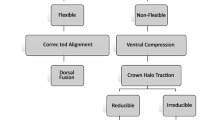Abstract
This is a retrospective study of 76 children who had had malignant tumours treated with laminectomy or laminoplasty and/or radiation therapy affecting the spine. Spinal tumours in children are extremely rare. However, their treatment can result in progressive spinal deformity. Radiation therapy affecting the growing spine can lead to asymmetric vertebral growth, causing kyphosis and/or scoliosis. These spinal deformities pose one of the most challenging problems for the spine surgeon. The aim of this article is to describe late-onset post-laminectomy/post-radiation spinal deformities and to evaluate the results of their treatment. Seventy-six children, with a mean age of 4 years and 7 months (range, 2 months to 16 years), underwent surgical removal of malignant tumours, between 1961 and 1995. Sixty-seven of them developed post-laminectomy/post-radiation spinal deformity. Conservative treatment consisted of bracing and corrective plaster casts. In 46 cases the deformity was treated surgically. A distraction plaster cast was used as preoperative preparation in the more severe and rigid curves, with or without neurological impairment. Surgery consisted of combined anterior and posterior fusion in 39 cases and posterior fusion in seven cases. Posterior instrumentation was used in 38 cases. The mean follow-up period was 6 years and 7 months (range, 9 months to 20 years and 2 months). Nine children did not develop deformity following the primary tumour treatment. One of them underwent laminectomy with posterolateral fusion and eight had laminoplasty combined with external immobilisation. Forty-six children developed iatrogenic kyphosis and underwent surgical correction from a mean of 75° pre-correction to a mean of 32°. The mean scoliotic angle correction was 66° preoperatively to 34° postoperatively. At follow-up, the mean correction loss was 7° in the sagittal plane and 5° in the coronal plane. Preoperative distraction plaster cast treatment resulted in a correction of 39% in kyphosis and of 58% in scoliosis, and in a partial or complete recovery of neurological deficits in all but one patient. In severe and rigid curves that develop following treatment of paediatric spinal tumours, preoperative application of a distraction plaster cast can reduce deformity and facilitate surgical correction. Furthermore, in the case of pure bony compression of the spinal cord due to the apical vertebra of the deformity, treatment with the distraction plaster can result in recovery from the neurological impairment. The prevention of post-laminectomy/post-radiation spine deformities is emphasised. Rigid external immobilisation for a period of 4 months in the cervical spine and of 6 months in the thoracic spine is recommended after both laminoplasty and laminectomy with posterolateral fusion.

Similar content being viewed by others
References
Albert TJ, Vacarra A (1998) Post-laminectomy kyphosis. Spine 23:2,738–2,745
Arkin AM, Simon N (1950) Radiation scoliosis. J Bone Joint Surg Am 32:396–404
Cattel HS, Clark GL Jr (1967) Cervical kyphosis and instability following multiple laminectomies in children. J Bone Joint Surg Am 49:713–720
de Jonge T, Dubousset J, Illés T (2002) Hyperrotatory paradoxic kyphosis. Spine 27:393–398
Dubousset J (1980) [Spine deformities induced by radiation of Wilms tumors]. Rev Chir Orthop 66:441–451
Dubousset J (1994) Instability of the spine secondary to the treatment of intraspinal tumors in children: diagnosis, cure, and prevention. In: Holtzman RNN, McCormick PC, Farcy JP (eds) Spinal instability (Contemporary perspectives in neurosurgery). Springer, Berlin Heidelberg New York, pp 219–236
Dubousset J (1994) Three-dimensional analysis of the scoliotic deformity. In: Weinstein SL (ed) The pediatric spine: Principles and practice. Raven Press, New York, pp 479–496
Dubousset J, Guillaumat M, Mechin JF (1973) Retentissement rachidien des laminectomies chez l’enfant. In: Rougerie J, (ed) Compressions médullaires non traumatiques de l’enfant, vol 1. Masson, Paris, pp 185–193
Hermann JM, Sonntag VKH (1994) Cervical corpectomy and plate fixation for post-laminectomy kyphosis. J Neurosurg 80:963–974
Lonstein JE (1977) Post-laminectomy kyphosis. Clin Orthop 128:93–100
Mikawa Y, Shikata J, Yamamuro T (1987) Spinal deformity and instability after multilevel cervical laminectomy. Spine 12:6–11
Neuhauser EBD, Wittenborg MH, Berman CZ, Cohen J (1950) Radiation effects of roentgen therapy on growing spine. Radiology 59:637–650
Otsuka NY, Hey L, Hall JE (1998) Post-laminectomy and post-radiation kyphosis in children and adolescents. Clin Orthop 354:189–194
Papagelopoulus PJ, Peterson HA, Ebersold MJ, Emmanuel R, Choudhury SN, Quast LM (1997) Spinal column deformity and instability after lumbar or thoracolumbar laminectomy for intraspinal tumors in children and young adults. Spine 22:442–451
Peterson HE (1994) Iatrogenic spinal deformities. In Weinstein SL (ed) The pediatric spine: principles and practice. Raven Press, New York, pp 651–664
Raimondi AJ, Gutierrez FA, Di Rocco C (1976) Laminotomy and total reconstruction of the posterior spinal arch for spinal canal surgery in childhood. J Neurosurg 45:555–560
Robert H, Bortolussi C (1984) [In vitro evolution of the pressure and the geometry of the lumbar disc as a function of the stability of the spine.] J Biophys et Med Nucl 8:243–249
Shikata J, Yamamuro T, Shimizu K, Saito T (1990) Combined laminoplasty and posterolateral fusion for spinal canal surgery in children and adolescents. Clin Orthop 259:92–99
Sim FH, Svien HJ, Bickel WH, Janes JM (1974) Swan-neck deformity following extensive cervical laminectomy. J Bone Joint Surg Am 56:564–580
Stagnara P (1985) Les déformations du rachis. In: Stagnara P (ed) Scolioses, cyphoses, lordoses. Masson, Paris, pp 199–252
Tachdjian MI, Matson DD (1965) Orthopaedic aspects of intraspinal tumors in infants and children. J Bone Joint Surg Am 47:223–248
Author information
Authors and Affiliations
Corresponding author
Additional information
The research was carried out at Saint Vincent de Paul Hospital, Department of Pediatric Orthopaedic Surgery, Paris
Rights and permissions
About this article
Cite this article
de Jonge, T., Slullitel, H., Dubousset, J. et al. Late-onset spinal deformities in children treated by laminectomy and radiation therapy for malignant tumours. Eur Spine J 14, 765–771 (2005). https://doi.org/10.1007/s00586-004-0778-1
Received:
Revised:
Accepted:
Published:
Issue Date:
DOI: https://doi.org/10.1007/s00586-004-0778-1




